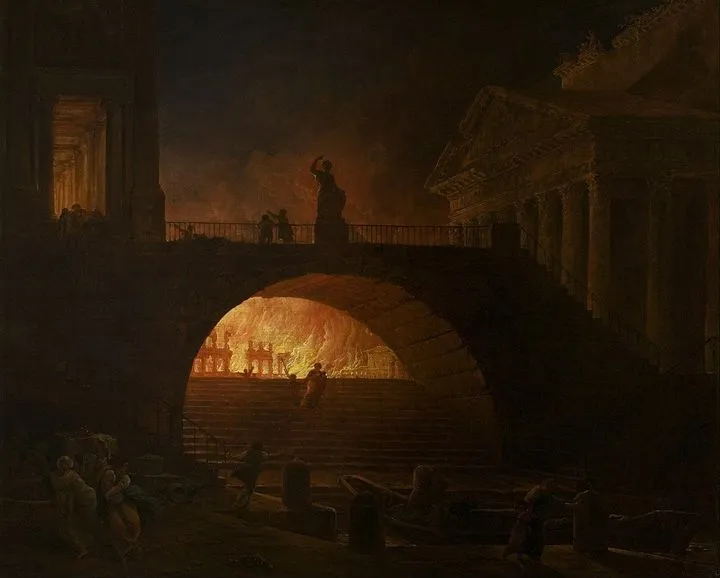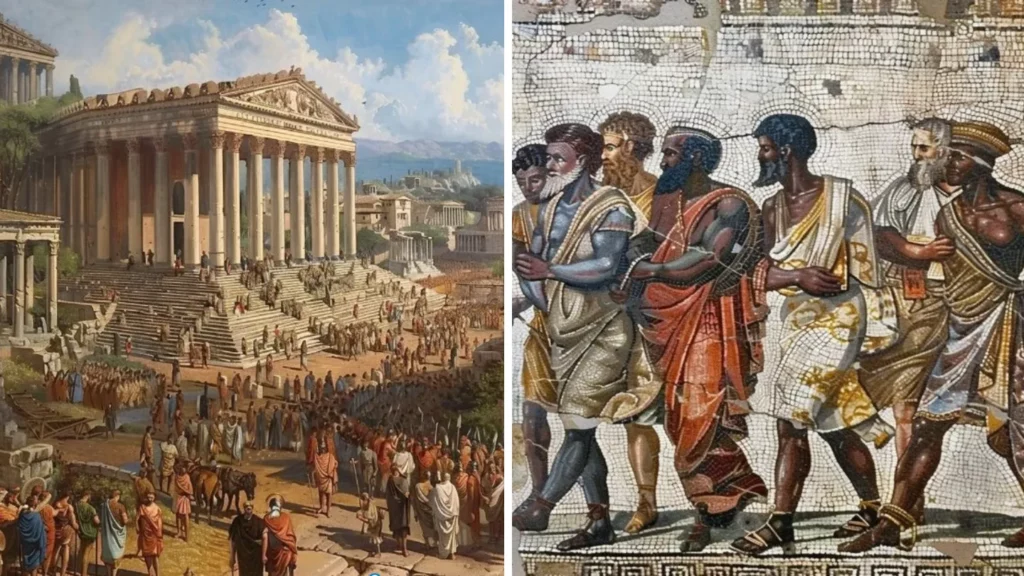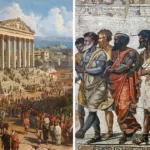When we think of ancient Rome, Julius Caesar, the Colosseum, and gladiators come to mind. There’s no denying that the Roman Empire, which spanned from 753 BC to 476 AD, was an iconic era of ancient history. Ancient Rome’s influence can be seen across many centuries, even shaping the Western world today.
From pet lions to violent chariot races, Roman society was full of surprises. Prepare to throw out everything you thought you knew about ancient Rome because we’re about to reveal what life was really like.
Gladiators Were Trained to Die
The life of a gladiator revolved around entertaining crowds and emerging victorious. Gladiatorial combat was as much about the spectacle as it was about survival, so gladiators were trained not only in combat skills, but also in the fine art of delivering and receiving the fatal blow.

While not all fights resulted in death, some gladiators did lose their lives in the arena. As the popularity of gladiator fighting grew throughout the Roman period, the fights became more brutal. In the 3rd Century, the mortality rate was around 25% of gladiator fighters.
Slaves Could Buy Their Freedom
Slavery had a long and complicated history in the ancient world. One way that Roman slavery differed from other cultures was that they had the concept of Manumission—meaning slaves were able to be freed.

Some Roman slave owners just freed their slaves outright, while others allowed them to pay for their own freedom using any money they’d saved as gifts. The prospect of potential freedom encouraged slaves to be hardworking and obedient, but the process was complicated. Some slaves never earned enough to buy their freedom and some after being freed still found the stigma of slavery hard to overcome.
Romans Had Short Work Days
In Rome, the workday was all about productivity and leisure in equal measure. With no clocks, Romans relied on the sun to wake them up around 6 a.m. They’d eat breakfast and then get right to work until the early afternoon—then it was time to relax.

Only a few stores would stay open past the early afternoon hours, as most people were busy watching gladiator competitions, chariot races, and wrestling matches, or visiting the baths or the theater. Most taverns stayed open all day as social hubs for eating and drinking.
Fires Were Extremely Common
People in ancient Rome didn’t have access to the same building materials we have today. Roman insulation was made from wood and mud, meaning they were susceptible both to crumbling down, and catching on fire.

Thanks to the densely populated and tightly packed nature of the city, fires were a constant threat, and they weren’t helped by Romans using hot coals and open flames to cook food in their homes. One of the most infamous was the Great Fire of Rome in 64 AD, which raged for six days and seven nights, destroying much of the city.
Banquets Followed the Same Format
For the wealthiest folk living in ancient Rome, simply hosting a banquet wasn’t enough. Banquets were about so much more than just eating and drinking—they were also important social and political events, where guests could network, form alliances, and display their wealth and status.

Each banquet usually followed the same extravagant format. Guests reclined on couches while dining, beginning with appetizers, then a main course, followed by entertainment from acrobats and musical performers. Sometimes, the chefs would even sing as they served their food. If the host was particularly wealthy, it wasn’t uncommon for live lions and bears to make an appearance.
The Ancient Mountain Made of Pots
Olive oil was a huge deal in ancient Rome. The Romans imported it from across the world, to be used at the baths, in medicine, and more. They consumed such a vast quantity of oil that they soon found themselves overwhelmed with a mass of empty terracotta containers, and nothing to do with them.

These broken pots were discarded after use because the oil residue would turn rancid, making them unsuitable for reuse. Over time, these discarded pots accumulated into a massive artificial mound that still exists today on Monte Testaccio, also known as “Potsherd Mountain”.
Emperors Owned Wild Animals
There are strange and eccentric emperors dotted throughout Roman History. With all the power and the support from the public, they were free to flaunt their wealth and put all kinds of unusual laws into action.

Emperor Elagabalus was one of the more eccentric rulers of Rome. He was just a teenager when he started his reign and was known for his scandalous parties, disregarding all the traditional Roman customs. Like many other emperors, he owned wild animals including lions and bears, which he allowed to roam freely around his parties.
Baking Was a Lucrative Job
In Roman times, grain was a form of currency, but there’s not much you can do with grain apart from baking it into bread. Most Romans didn’t have ovens in their homes, which meant that bakers played an incredibly important role in society.

Being a bread baker in ancient Rome was not only a prestigious role, but a lucrative one, too. The men who controlled the bread and commercial ovens were well-liked and respected. They often ran for political office and influenced civic elections.
Gladiators’ Armor Was Only for Show
If you thought there was only one type of gladiator in ancient Roman times, you’d be sorely mistaken. It’s estimated that there were actually more than 24 types, each with their own armor and weapons to use in the arena. It might have looked impressive, but it was mostly for show.

The armor wasn’t based on actual armor used on the battlefield. While some gladiators wore full suits of armor, others wore minimal protection to allow for greater mobility while fighting. It was designed to keep things fair and make it more entertaining for the audience.
There Were No Trained Doctors or Hospitals
Anyone who needed serious medical attention in ancient Rome was just about out of luck. Back then, there was no such thing as a trained doctor, and the closest thing to a hospital was a tent on the battlefield where soldiers would go to rest.

Roman residents instead had to rely on self-proclaimed doctors, a title that anyone could adopt without any formal qualifications. Success was often measured by the ability to keep patients alive rather than by advanced medical knowledge. Since autopsies were not allowed in Rome, people knew very little about the inside of the human body.
Justice Was Based on Social Status
In ancient Rome, justice was heavily influenced by social status. There was no police force, but this didn’t mean people acted without restraint. If someone caused another’s death, it was down to the victim’s family to seek justice, usually resulting in the offender’s death, unless they were of higher social status.

The judicial system was eventually established later, allowing accusations against higher-ups, but wealth often swayed the outcome. The elite usually got off lightly with lenient punishments, thanks to their perceived contributions to society, while people of lower status were left with harsh punishment. This system ensured a sense of social order, but still favored the powerful.
Branding Started in Rome
These days, it’s pretty common to put your name on something you’ve made. It turns out that this practice is nothing new—people in Rome were branding their items before selling them. Everything from bread to pottery to glassware was branded.

One of the most famous examples was Aulus Umbricius Scaurus, the Pompeii citizen labeled as a legendary fish sauce producer. He was so good at marketing and branding his name on mosaics, pottery, and fish sauce bottles that Aulus Umbricius Scaurus appeared on about 29% of fish sauce containers in Pompeii.
Rome Was Covered in Billboard Advertising
These days, it’s common for companies to spend millions of dollars on their advertising budget, especially for major events like the Super Bowl. But did you know that this was happening all the way back in ancient Rome?

The Roman Games were a major event across the city, and you might be surprised to learn how much they were advertised. Emperors would commission huge murals on walls, people would graffiti portraits of specific gladiators, and handouts were distributed on the streets to convince people to attend. Emperor Augustus even once used live crocodiles to advertise his games.
Worshipping the Many Gods
The Roman Empire was a polytheistic civilization, meaning they recognized and worshiped multiple gods and goddesses—at least 67, to be precise. That’s not even including all the demigods!

Jupiter, Juno, and Minerva were among the main deities, and since people in ancient Rome believed that everything was protected and governed by spirits, including rivers, trees, and their homes, they often built shrines for them. These weren’t just for worship, but also as a way to show off their wealth. The more impressive your shrine, the wealthier you were in Roman society.
One Goddess Had Her Own Cult
Ancient Romans borrowed deities from all kinds of cultures, and one of the most culturally significant was Cybele. Also known as Magna Mater (Great Mother), Cybele was a Phrygian goddess who symbolized fertility, motherhood, and the earth. She even had her own cult of followers with some interesting rituals.

The worship of Cybele involved ecstatic ceremonies, with the males devoting themselves to her service through castration. The cult of Cybele was officially recognized by the Roman Senate in 204 BC, and the annual festival in her honor, known as the Megalesia, became one of the most important religious festivals in Rome.
Octopus Was the First Urban Legend
If stories from ancient Rome are anything to go by, urban legends are not a modern creation. Aelian, a writer from the 3rd century AD, was one of the first people to document what’s considered one of the first urban legends, the story of a giant octopus who terrorized the city of Puteoli.

According to the legend, the octopus grew tired of its sea diet and ventured into the city through the sewer system to feast on pickled fish in a merchant’s shop. The creature was so large that it took a group effort to capture or kill it.
Female Slaves had a Tough Time
In ancient Rome, female slaves led harsh and often brutal lives, with little control over their fates. They were considered property and could be bought, sold, or punished at their owners’ will.

Some female slaves were used as domestic servants, while others were forced into more personal roles, including being concubines or entertainers. These women often had to endure grueling work and mistreatment, but a few managed to earn their freedom or gain influence within the household through cunning and resilience.
Cold Plunging is Nothing New
In Ancient Rome, bathhouses were not just for relaxation but also for fitness. Many thermae featured palaestrae, or exercise areas, where patrons could engage in various physical activities before their bath.

The fitness regimens included wrestling, weight lifting, and ball games, which helped maintain physical prowess. Bathers would work up a sweat and then enjoy the caldarium (hot bath), tepidarium (warm bath), and frigidarium (cold plunge) to relax and cleanse themselves, as a solo activity or with their Roman friends.
Praying Looked Very Different
In ancient Rome, religion played a significant role in daily life, with people often praying to the spirits around them. Since the gender of these spirits was often unknown, they would address them as “god or goddess” to avoid offending them because getting their gender wrong could have meant they were ignored.

Romans sought to cover all bases and find loopholes in their religious practices to ensure their prayers were heard. Rituals and sacrifices were common ways to appease these spirits, such as farmers sacrificing a pig before plowing the land. This practice was believed to make up for disturbing the ground.
Baths Were Mostly Men-Only Zones
While some Roman bathhouses had designated times or separate facilities for women, they were generally restricted from the largest and most elaborate baths, which were primarily male-only domains. This exclusion was largely due to the Roman social structure and moral codes, which prioritized modesty and controlled interactions between genders.

Additionally, Roman men viewed the baths as vital spaces for social, political, and business networking, spheres from which women were often excluded. Despite clean facilities for women, cultural norms significantly limited their access and participation in these central communal activities.
It Paid to Be a Chariot Racer
Did you know that most chariot racers in ancient Rome were slaves? Chariot racing was a lucrative business, especially for the racers themselves. That’s why many slaves eagerly participated despite the danger because victory meant a big share of the winnings.

Betting on chariot races was also a popular practice. Some racers would even bet on themselves so they could walk away with substantial earnings. And in case you were wondering, there was no loyalty, either. Drivers frequently switched teams to join the most successful ones—white and red.
Slaves Wore Plaques as Punishment
In ancient Rome, slaves who attempted to escape or displayed misconduct were often punished by being forced to wear a “furca” or a plaque around their necks. This plaque, called a “titulus,” would typically bear inscriptions detailing the slave’s name, offense, and contact information for their owner, effectively serving as a form of public humiliation and deterrence against further disobedience.

These plaques not only signified the slave’s status but also made their capture and return easier if they attempted to escape again, reinforcing the control exerted by slave owners.
Was the “Thumbs-Down” From “Gladiator” Real?
The epic movie Gladiator saw ancient Rome brought back to life on the big screen. One of the most iconic scenes is when the emperor decides the gladiators’ fate with a thumb facing up or down. But did that really happen in the stadiums of Rome?

There’s been extensive debate about what the precise gestures really meant or whether the judges really used their thumbs in the first place. Some historians suggest the opposite to the movie, that a “thumbs down” signified the losing gladiator was to be spared while the “thumbs up” meant he was to be killed.
Emperors Mingled at the Baths
Using public baths was an everyday experience for the Romans, and it didn’t take them long to become breeding grounds for illnesses. However, this did not stop emperors from showing up to the baths like local celebrities, to mingle with the public and help their public campaign.

While regular plebeians resorted to rubbing against stone walls or applying oil to exfoliate at the baths, the emperors enjoyed the luxury of having an entourage to cater to their every need. These people were responsible for carrying their robes, rubbing oil on the emperor’s skin, and using a tool called a strigil to scrape it all off.
Marble Heads Without Bodies
Anyone who’s been to a museum will have seen plenty of sculptures depicting prominent figures from the ancient Roman era. Have you ever wondered why many of the marble heads of Roman senators, philosophers, and emperors are missing their bodies?

This strange phenomenon is because crafting full marble statues was so time-consuming. The life span and reign of some emperors were so short that they’d die before the artist was finished sculpting the entire body. It was far more efficient to create detachable heads, allowing for interchanging heads on a single body.
Inflation Caused Financial Strain
Inflation has been a social concern ever since the days of ancient Rome. Currency changed throughout the Roman empire and different emperors tried various strategies to combat it. Since prices often depended on peoples’ wages, financial hardships were common.

Emperor Diocletian imposed price controls to curb inflation, but it didn’t really work. There was such a big discrepancy in wages for people like farmers compared to painters and skilled artisans. This meant that affording basic items like boots, could require weeks of work.
Rome Overflowed With Imported Goods
Rome was a successful civilization in one area in particular: population growth. It wasn’t long before there was far more demand than supply for their booming population, so the solution was to import goods from across the Mediterranean, and every country had something new and exciting.

From wood and salt to pigs, ivory, and jewels, Rome’s markets overflowed with treasures. It meant that Roman citizens could enjoy the excitement of items from around the world. But of course, the imported goods were only available to the people who could afford them.
Emperor Nero’s Reign of Tyranny
Emperor Nero was the great-great-grandson of Rome’s first-ever emperor, Augustus. He came to power in 54 A.D. when he was just 17 years old, and after his catastrophic 14-year reign, forever became known as the worst ruler in Rome’s history.

Sure, he can be thanked for reforming the tax system and improving Rome’s food supply, but he also had some questionable hobbies. Nero was known to have entertained himself by donning a disguise, wandering the streets, stabbing people, and throwing their bodies into sewers. It was only after the Senate condemned him to death that his tyranny came to an end.
Romans Loved Chariot Racing
In ancient Rome, the only sport more popular than gladiator fights was chariot racing. It was like the ancient version of NASCAR—except far more dangerous. The races began with a grand parade through Rome’s streets, building excitement before the chariots thundered into stadiums like the impressive Circus Maximus, where over 200,000 eager spectators awaited.

Charioteers raced for different teams, identified by their colors—red, white, blue, and green—each had their own loyal fan base of people from all societal classes watching as they raced at breakneck speeds, circling the 2,000-foot-long sand track.
Communal Bathrooms Often Exploded
The sewer system across ancient Rome was far from what it is today, but it was an incredibly impressive feat at the time. Constructed in the 6th Century BC, the Cloaca Maxima was designed as a sewage system to improve the growing city.

With so many communal bathrooms, called Latrines, dotted across public areas, it didn’t take long for dangerous gases like methane to build up. Since the sewer system had vaulted ceilings and limited ventilation, the sewers were not immune to the occasional explosion or toilet fire.
Public Turned on Emperor Pompey
Emperors in ancient Rome understood the importance of maintaining the support of the people, as their favor was crucial for political stability. The Roman Games were a key tool for keeping the population entertained. Even esteemed figures like General Pompey were not immune to the consequences of misjudging the public’s mood.

He made a controversial decision to include 20 elephants in his Games, bringing them out one by one to be hunted. It backfired once the elephants tried to escape, and the audience sensed their distress. The crowd turned on Pompey and sealed his fate as one of the most reviled emperors in history.
Romans Believed in Witchcraft
In ancient Rome, witchcraft and magic were deeply ingrained in society—both respected and feared. Despite attempts to regulate magic through the law, it was widespread, and many Romans sought out practitioners like witches or sorcerers to help them.

Common practices included the use of magical texts, binding curses, ritual figurines, and spells. In the Republic and Imperial periods, people even used poisons that were considered to be like magical potions to achieve specific goals like keeping people quiet or providing protection.
Romans Created the First-Ever Joke Book
Humor has been a timeless constant in human culture since the very beginning. Though the Romans seem very serious, history shows the opposite. In the 3rd or 4th century, around the time of the Fall of the Roman Empire, the Romans created the Philogelos—what is now considered the first joke book.

The title translates to “The Laughter Lover”, and the book contains 265 jokes revolving around themes such as marital infidelity, bodily functions, and social stereotypes. It’s hard to tell if they’d still be considered funny today, but it shows that humor has always been around.
Gladiators Were Far From Glamorous
Gladiators were the celebrities of Rome. These highly renowned figures have been the subject of poems and films for centuries, but the reality of their existence was far more bleak than it’s made out to be. Gladiators gave up all their independence, enslaved to their Ianista—the person who controlled every aspect of their lives—including a grueling training and eating schedule.

Most gladiators were previously social outcasts or former slaves, and people avoided becoming gladiators at all costs because they had to surrender their freedom for battle. Some resorted to desperate measures to escape their circumstances, including taking their own lives or fleeing the city.
Poor People Lived in High Rises
Rome was one of the first cities to house more than one million people. Of course, that meant they all needed somewhere to live, and the streets of Rome were famously extremely overcrowded with people and housing.

Their solution was to build upward instead of outward, creating high-rise apartment buildings called “insula”, standing up to 100 feet tall. The bottom floors were saved for those with more money, while poorer people were stuck at the top, at risk of fire and crumbling infrastructure.
Slaves Endured Unimaginable Punishments
The experience of life as a Roman slave varied widely depending on their owners. Those working for landowners would often endure grueling physical tasks, while slaves owned by the city would be responsible for constructing public buildings.

If a slave owner passed away, all the slaves were subjected to torture, and if any one of them was found guilty of a crime, they could all be sentenced to death. Emperor Augustus was known for being particularly cruel to slaves, punishing them by throwing them into pools of eels. These cruel rules only changed when Emperor Hadrian created laws making it illegal to kill slaves.
Romans Borrowed Gods From Other Cultures
As the Romans expanded their empire, they were also known for adopting cultural practices they encountered along the way. One of the most common was assimilating and incorporating gods and goddesses from other cultures into their own religious practices. Roman soldiers would pray to the respective city’s god, inviting them to join the festivities in Rome once the area was conquered.

This process, known as “syncretism”, allowed them to adapt and adopt new beliefs and deities as they encountered them. For example, the Roman god Mithras, associated with Persian mythology, soon became popular among Roman soldiers.
Roman Games Put Caesar in Debt
Emperor Julius Caesar is one of the most famous names in Roman history and his time as host of the Roman Games probably helped him reach that status. In order to impress the spectators, he would often make big promises of grandeur. Of course, that also meant fulfilling his promises.

Caesar imported exotic animals from Africa and once had 320 gladiators wearing silver armor fighting all at once. However, Caesar also amassed a mountain of debt thanks to his relentless pursuit of becoming Emperor.
Interesting Bruise Remedy
Most of us have had a bruise or two before, but it’s safe to say that they were far more common in ancient Rome thanks to the constant fights, overcrowded streets, and rowdy city life. Medicine back then combined scientific knowledge with religion and supernatural beliefs, and there was one particularly interesting remedy used to treat bruises: wild boar droppings.

Doctors often used dried boar droppings soaked in vinegar to treat a bruise. Chariot racers, who experienced cuts and bleeding, preferred fresh droppings for their medicinal properties.
Firefighters Were Also Police
Crime was rife throughout ancient Rome, and it was likely because there was never a proper police force to keep the peace. Instead, it was mainly the duty of the citizens themselves to maintain order in the city—assisted sometimes by The Vigiles.

The Vigiles were a firefighting and policing force in ancient Rome, established by Emperor Augustus around 6 AD. They were equipped with buckets, hooks, and pumps for firefighting, but they also served as a rudimentary form of police, dealing with crimes like theft and vandalism.
There Were Female Gladiators
Gladiator fighting was not only reserved for men in ancient Rome. While they were far less common than their male counterparts, women did compete in gladiatorial combat.

Emperor Caesar and Emperor Domitian were just two of the game editors in history who chose to have women competing in their Roman Games. That all changed by the time 200 AD rolled around because the ruling Emperor Septimius Severus banned all females from the arena.
People Committed Insurance Fraud
Considering that fires were so common in ancient Rome, it’s no surprise that the people began to invest in fire insurance. Of course, it was a major luxury that only the wealthiest of people could afford. It also meant that the Romans were some of the first people to face instances of insurance fraud.

People began to invest in their homes and protect the contents with insurance, only for them to mysteriously burn down because people were often given more money for their homes than they were worth. Emperor Augustus combatted this issue by enforcing harsh punishments for anyone found guilty of committing arson.
Banquets Were the Pinnacle of Opulence
If there was one thing that the social elite in Rome loved more than anything else, it was showing off their wealth. The wealthiest people in society would flaunt their riches through extravagant banquets, where their opulence was on full display.

The dining setup usually featured three couches made of gold and ivory arranged in a U-shape around a lavish table. The table itself was adorned with luxury cutlery and drinking vessels crafted from expensive materials like bronze, silver, and gold, or exquisite Roman glass. They were designed to be nothing short of extraordinary.
Dogs Were Treated as Family
Dogs have long been considered man’s best friend, and it turns out that humans have been loving dogs for tens of thousands of years, as so much more than just pets. They were treated as part of the family in ancient Roman society, and considered highly valuable for their loyalty and hunting skills.

Large Molossian dogs were reserved for hunting and guarding, while smaller breeds like the Maltese were kept as companions. Mosaics and paintings honoring dogs could also be seen throughout the city.
Men Were Powerful, Women Were Not
In Roman society, there was a major gender power imbalance. Men held the majority of power and authority within the family. They had control over important decisions such as arranging marriages, divorcing their wives, and even deciding the fate of newborns if they didn’t fancy another child or couldn’t afford the addition to the family.

Women, on the other hand, had limited rights and freedoms. They were expected to marry, bear children, and manage the household. Women were often relegated to domestic roles such as nursing, serving, or crafting.
One Holiday Turned Rome Upside Down
People in ancient Rome loved nothing more than letting their hair down. Parties were usually just for the wealthy, but on one special occasion, businesses and law courts were closed so that everyone could take part.

Saturnalia, the festival honoring Saturn, originally took place on one day, December 17, but over the centuries the festivities grew to last a whole week. During Saturnalia, social norms were overturned, and roles were temporarily reversed, with masters serving their slaves, and slaves being allowed liberties and treated as equals. The festival was seen as a time of joy and freedom from the usual restraints of Roman society.
Streets of Rome Were Dangerous
It was hazardous to walk through the streets of ancient Rome, for a whole host of reasons. With so many buildings being built to accommodate the growing population, it wasn’t long before the streets became smaller and narrower. People walking through the streets had to be extremely vigilant.

If it weren’t for the falling roof tiles thanks to cheap and poor construction, it was the risk of being crushed due to high population density. If that weren’t bad enough, the lack of sanitation meant that people emptied chamber pots right into the street, so there were unpleasant odors at every turn.








